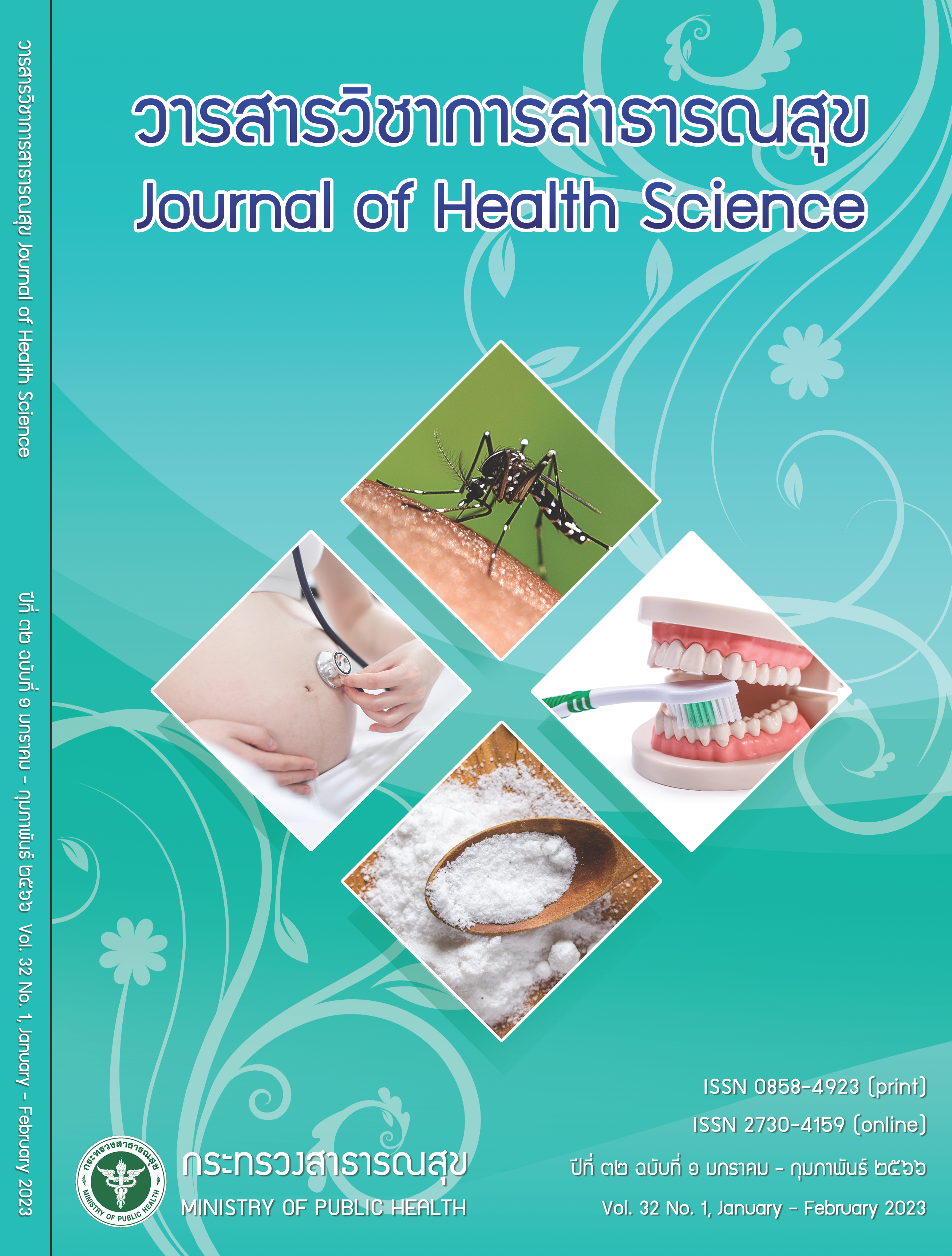Development of Early Warning Sign Model in High-Risk Patient, Songkhla Hospital
Keywords:
monitoring model, early warning signs, high-risk patientAbstract
This research aimed to develop and study the results of a early warning signs model in high-risk patients at Songkhla Hospital. There were 3 phases of this research: (1) situation analysis by reviewing medical records of 10 deteriorate patients, focus group discussions of which 15 head nurses and 20 professional nurses were used for qualitative data analysis; (2) developed model by literature review to create a guideline for monitoring the warning signs of a crisis; and (3) evaluated the results of the developed model. The samples were 150 registered nurses and 200 high-risk patients from whom the data were collected before and after development. Quantitative data were analyzed by using percentage, mean, standard deviation and independent t-test. The results showed that in Phase 1, there was no use of alarm monitoring tools. From the focus group discussion, it was found that crisis monitoring capability was insufficient combining with late doctor’s report. The early warning signs model in high-risk patients Songkhla Hospital consists of 2 components: (1) guidelines for monitoring early warning signs of crisis, and (2) guidelines for developing professional nurses’ competency of early warning signs. As for the results, the number of deteriorations after development was lower than before; and the mean scores of nursing performance after development were significantly higher than before (p<0.01). In addition, the scores of compliance with the guidelines for monitoring early warning signs of crisis were at a high level (90.5%). Thus, this early warning signs model should be introduced into the management system for critical conditions in high-risk patients in order to increase the competency of nurses and the safety of patients.
Downloads
References
World Health Organization. Towards eliminating avoidable harm in health care. [Internet]. 2021[cited 2022 December 5]. 108 p. Available from: https://www.who. int/publications/i/item/9789240032705
สถาบันรับรองคุณภาพสถานพยาบาล. มาตรฐานโรงพยาบาล และบริการสุขภาพ ฉบับที่ 4. นนทบุรี: สถาบันรับรอง คุณภาพสถานพยาบาล; 2560.
Mathukia C, Fan WQ, Vadyak K, Biege C, Krishnamurthy M. Modified early warning system improves patient safety and clinical outcomes in an academic community hospital. J Community Hosp Intern Med Perspect. [Internet]. 2015 [cited 2022 Jan 3]; 5(2):1-6. Available from: https://www.ncbi.nlm.nih.gov/pmc/articles/ PMC4387337
กรรณิกา ศิริแสน. ประสิทธิผลของการใช้ระบบสัญญาณเตือน ในการพยาบาลผู้ป่ วยในหอผู้ป่ วยวิกฤติ โรงพยาบาลเอกชน แห่ งหนึ่ งในกรุงเทพมหานคร [วิทยานิ พนธ์]. กรุงเทพมหานคร: มหาวิทยาลัยกรุงเทพคริสเตียน; 2558. 102 หน้า.
Christensen D, Jensen NM, Maalae R, Rudolph SS, Belhage B, Perrild H. Nurse-administered early warning score system can be used for emergency department triage. Dan Med Bull. [Internet]. 2011[cited 2022 Jan 3];58(6):A4221. Available from: https://pubmed.ncbi. nlm.nih.gov/21651873
Wang AY, Fang CC, Chen SC, Tsai SH. Periarrest Modified Early Warning Score (MEWS) predicts the outcome of in- hospital cardiac arrest. J Formos Med Assoc. [Internet]. 2016[cited 2022 Jan 10] ; 115(2): 76-82. Available from: https://pubmed.ncbi.nlm.nih. gov/26723861
Nishijima I, Oyadomari S, Maedomari S, Toma R, Igei C, Kobata S, et al. Use of a modified early warning score system to reduce the rate of in-hospital cardiac arrest. JIntensive Care. [Internet]. 2016[cited 2022 Jan 3]; 4:12. Available from: https://www.ncbi.nlm.nih.gov/pmc/ articles/PMC4748572
Jayasundera R, Mark Neilly M, O Smith T, Myint PK. Are Early Warning Scores Useful Predictors for Mortality and Morbidity in Hospitalised Acutely Unwell Older Patients? A Systematic Review. J Clin Med. [Internet]. 2018 [cited 2022 Jan 3] ; 7(10): 309. Available from: https://pubmed.ncbi.nlm.nih.gov/30274205
นิตยาภรณ์ จันทร์นคร. ทัศนีย์ แดขุนทด. อุไรวรรณ ศรีดามา, ปิยนุช บุญกอง. การพัฒนารูปแบบการประเมินสัญญาณ เตือนภาวะวิกฤต สำหรับผู้ป่วยหนัก วัยผู้ใหญ่ โรงพยาบาล สกลนคร. วารสารกองการพยาบาล [อินเทอร์เนต]. 2563 [สืบค้นเมื่อ 2022 Jan 3];47:39-60. แหล่งข้อมูล: https:// he01.tci-thaijo.org/index.php/JND/article/ view/242610/164904
Kemmis S, McTaggart R. The action research planner. 3rd ed. Geelong, Australia: Deakin University Press; 1988.
สุรีย์พันธุ์ วรพงศธร. การวิจัยทางสุขศึกษา. กรุงเทพมหานคร: วิฑูรย์การปก; 2558.
Alexander G. Behavioural coaching – the GROW model. In: Passmore J, editor. Excellence in coaching: the industry guide. 2nd ed. London, Philadelphia: Kogan Page: 2006. p. 83–93.
วิตมอร์, จอห์น. โค้ชชิ่งกลยุทธ์การโค้ชเพื่อพิชิตเป้าหมาย อย่างมืออาชีพ [coaching for performance] (วุฒินันท์ ชุมภู, ผู้แปล). พิมพ์ครั้งที่ 3. นนทบุรี: ภาพพิมพ์; 2010.
ณัฐรดา เจริญสุข, สุรินทร์ ชุมแก้ว, เกษราภรณ์ สุตตาพงค์. กลยุทธ์การสอนงาน (coaching) เพื่อสร้างสมรรถนะที่เป็น เลิศในการปฏิบัติงาน. วารสารการจัดการ 2559;4(2):60- 6.
รุ่งอรุณ บุตรศรี, สมพันธ์ หิญชีระนันทน์, ปราณี มีหาญพงษ์. ผลของการนิเทศตามโมเดลการโค้ชแบบโกรว์ของผู้บริหาร การพยาบาลระดับต้นต่อความสามารถในการปฏิบัติงานของ พยาบาลวิชาชีพ. วารสารมหาวิทยาลัยคริสเตียน. 2563; 26(2):84-96.
ภคินี ขุนเศรษฐ์. การประเมินผลการสอนงานพยาบาลในการ ประเมินสัญญาณเตือนก่อนเข้าสู่ภาวะวิกฤตในมารดา ตกเลือดหลังคลอด แผนกสูติกรรม โรงพยาบาลสงขลา [สารนิพนธ์พยาบาลศาสตรมหาบัณฑิต]. สงขลา: มหาวิทยาลัยสงขลานครินทร์; 2563.
Smith GB. In-hospital cardiac arrest: is it time for an in-hospital ‘chain of prevention”? Resuscitation [Internet]. 2010 [cited 2022 Jan 3];81(9);1209–11. Available from: https://www.resuscitationjournal.com
ลดาวัลย์ ฤทธิ์ กล้า. ผลของการใช้แนวทางการประเมินผู้ป่วย โดยใช้สัญญาณเตือนภาวะวิกฤตต่อการย้ายเข้าหอผู้ป่วยวิกฤตโดยไม่ได้วางแผนและอัตราการเสียชีวิตในหอผู้ป่วย อายุรกรรม TUH Journal online. [อินเทอร์เนต].2016 [สืบค้น 2022 Jan 3];1(1):1-8.
Downloads
Published
How to Cite
Issue
Section
License

This work is licensed under a Creative Commons Attribution-NonCommercial-NoDerivatives 4.0 International License.







